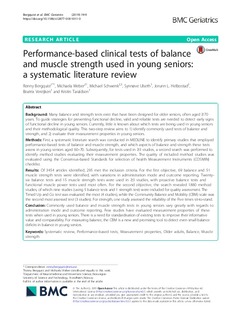| dc.description.abstract | Background
Many balance and strength tests exist that have been designed for older seniors, often aged ≥70 years. To guide strategies for preventing functional decline, valid and reliable tests are needed to detect early signs of functional decline in young seniors. Currently, little is known about which tests are being used in young seniors and their methodological quality. This two-step review aims to 1) identify commonly used tests of balance and strength, and 2) evaluate their measurement properties in young seniors.
Methods
First, a systematic literature search was conducted in MEDLINE to identify primary studies that employed performance-based tests of balance and muscle strength, and which aspects of balance and strength these tests assess in young seniors aged 60–70. Subsequently, for tests used in ≥3 studies, a second search was performed to identify method studies evaluating their measurement properties. The quality of included method studies was evaluated using the Consensus-based Standards for selection of health Measurement Instruments (COSMIN) checklist.
Results
Of 3454 articles identified, 295 met the inclusion criteria. For the first objective, 69 balance and 51 muscle strength tests were identified, with variations in administration mode and outcome reporting. Twenty-six balance tests and 15 muscle strength tests were used in ≥3 studies, with proactive balance tests and functional muscle power tests used most often. For the second objective, the search revealed 1880 method studies, of which nine studies (using 5 balance tests and 1 strength test) were included for quality assessment. The Timed Up and Go test was evaluated the most (4 studies), while the Community Balance and Mobility (CBM) scale was the second most assessed test (3 studies). For strength, one study assessed the reliability of the Five times sit-to-stand.
Conclusion
Commonly used balance and muscle strength tests in young seniors vary greatly with regards to administration mode and outcome reporting. Few studies have evaluated measurement properties of these tests when used in young seniors. There is a need for standardisation of existing tests to improve their informative value and comparability. For measuring balance, the CBM is a new and promising tool to detect even small balance deficits in balance in young seniors. | nb_NO |

